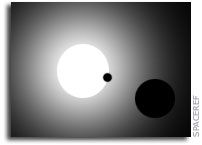A search for hot massive extrasolar planets around nearby young stars with the adaptive optics system NACO

http://images.spaceref.com/news/extrasolar.37.jpg
Astrophysics, abstract
astro-ph/0502376
From: Elena Masciadri [view email]
Date: Fri, 18 Feb 2005 15:37:16 GMT (400kb)
A search for hot massive extrasolar planets around nearby young stars
with the adaptive optics system NACO
Authors:
E. Masciadri (1),
R. Mundt (1),
Th. Henning (1),
C. Alvarez (1),
D. Barrado y Navascues (2) ((1) Max-Planck Institut fur Astronomie, (2) Laboratorio de Astrofisica Espacial y Fisica Fundamental)
Comments: 35 pages, 10 figures, pdf file, ApJ, accepted, see also
this http URL
We report on a survey devoted for the search of exo-planets around young and
nearby stars carried out with NACO at the VLT. The detection limit for 28 among
the best available targets vs. the angular separation from the star is
presented. The non-detection of any planetary mass companion in our survey is
used to derive, for the first time, the frequency of the upper limit of the
projected separation planet-stars. In particular, we find that in 50 % of
cases, no 5 MJ planet (or more massive) has been detected at projected
separations larger than 14 AU and no 10 MJ planet (or more massive) has been
detected at projected separations larger than 8.5 AU. In 100 % of cases, these
values increase to 36 AU and 65 AU respectively. The excellent sensitivity
reached by our study leads to a much lower upper limit of the projected
planet-star separation compared with previous studies. For example, for the
Beta Pictoris group, (~ 12 Myr), we did not detect any 10 MJ planet at
distances larger than 15 AU. A previous study carried out with 4 m class
telescopes put an upper limit for 10 MJ planets at ~ 60 AU. For our closest
target (V 2306 Oph – d = 4.3 pc) it is shown that it would be possible to
detect a 10 MJ planet at a minimum projected separation from the star of 1 AU
and a 5 MJ planet at a minimum projected separation of 3.7 AU. Our results are
discussed with respect to mechanisms explaining planet formation and migration
and to forthcoming observational strategies and future planet finder
observations from the ground.
Full-text: PostScript, PDF, or Other formats
References and citations for this submission:
SLAC-SPIRES HEP (refers to ,
cited by, arXiv reformatted);
CiteBase (autonomous citation navigation and analysis)
Which authors of this paper are endorsers?








